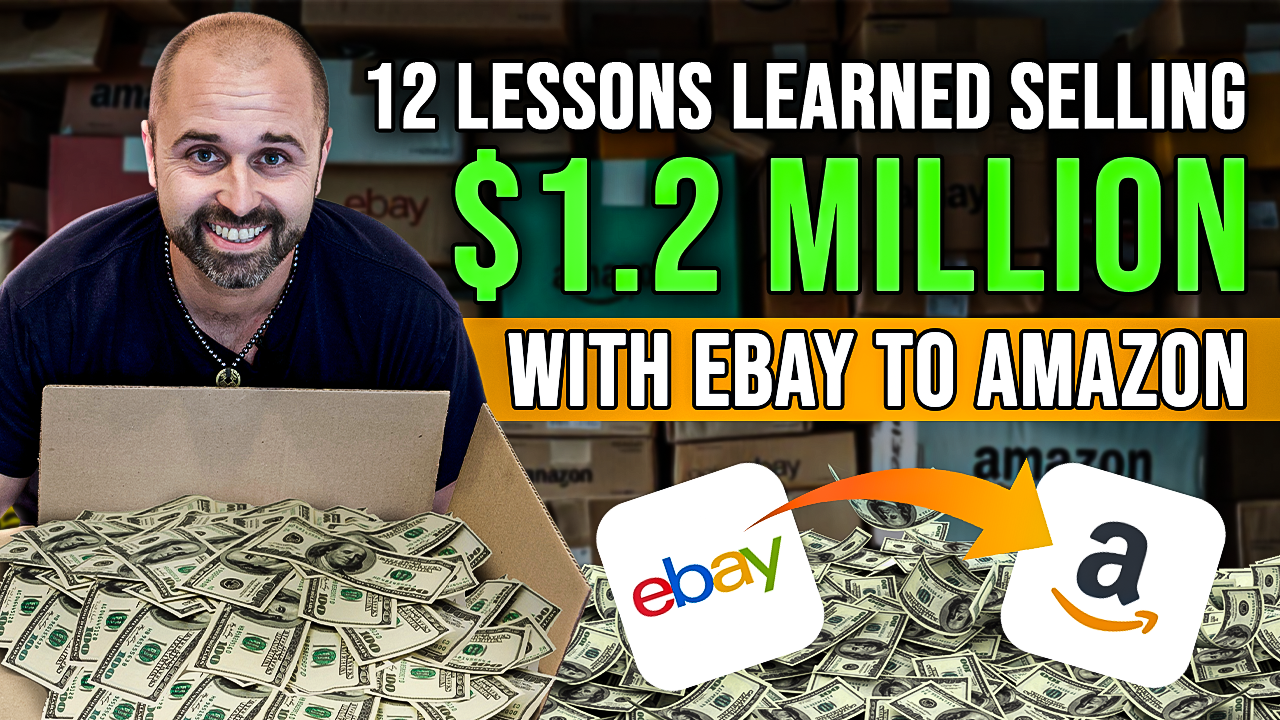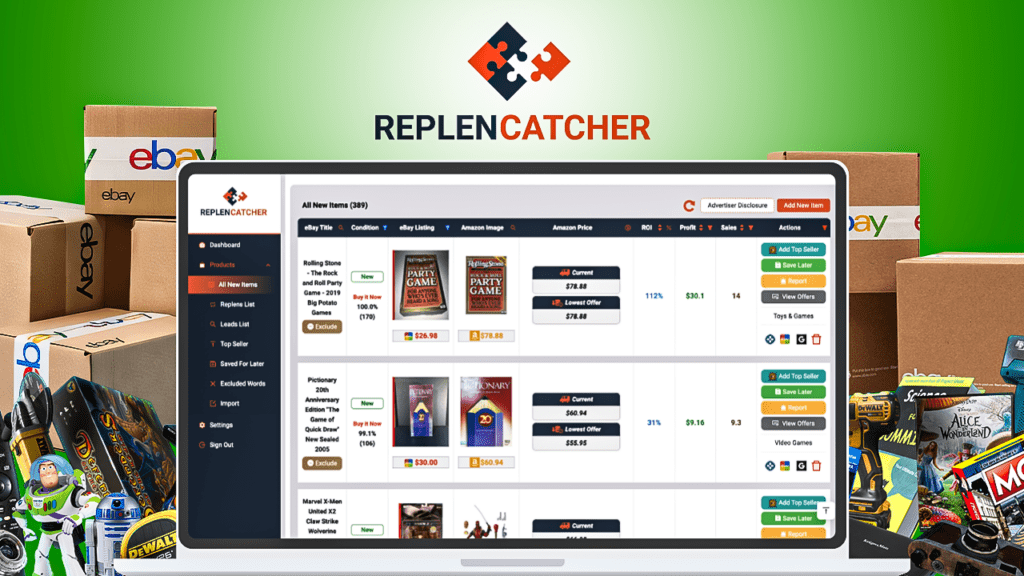
If you're an Amazon seller who's been thrifting and flipping on Amazon, stepping into eBay-to-Amazon or Amazon-to-Amazon flips can feel like an entirely different world.
It’s fast-paced, takes more capital, and requires a lot of finesse to ensure your profits stay high and your risks stay low.
I’ve spent years transitioning from thrifting to a fully-fledged Amazon Arbitrage model, where I now buy from eBay, Amazon, and even Facebook Marketplace to resell on Amazon.
Today, I’ll share the top 12 lessons I’ve learned in that transition to help you avoid my mistakes and get set up for profitable growth.
Lesson 1: Prioritize a Strong Sell-Through Rate & High ROI for Cash Flow Stability

One of the first lessons I learned after switching from thrifting to eBay-to-Amazon Arbitrage is the importance of balancing sell-through rate with ROI.
While thrifted items cost little and sell steadily, arbitrage products usually require a higher upfront investment and careful attention to cash flow.
Keys to Maintain Cash Flow:
ROI: Set a minimum ROI that ensures profitability. Many sellers, myself included, aim for at least 40% ROI, allowing some wiggle room for returns or unexpected price changes.
Sell-Through Rate: Look for products that sell consistently, even if they don’t sell every day. Use tools like Keepa and SellerAmp to understand a product’s monthly sales and price stability.

Starting with these standards ensures you keep a healthy cash flow, which becomes especially crucial as you scale up and begin to source higher-cost items.
Lesson 2: Increase Spending Strategically

One of the biggest mistakes I made early on was ramping up spending without fully understanding my inventory.
Spending more can certainly lead to more sales, but rushing to increase your spending without a solid plan will leave you with cash flow issues and unsold inventory.
How to Increase Spending Carefully:
Start with a Weekly Budget: Begin with what you can comfortably spend (e.g., $100-$200), then gradually increase it as you see predictable returns.
Track ROI and Sell-Through Rates: Use a spreadsheet or software to monitor your product performance. Gradually allocate more funds to items with reliable sell-through rates and higher ROIs.

Want to spend more money on eBay?
Consider checking out my favorite software Replen Catcher which can help you to source way more profitable products from eBay to Amazon.
Lesson 3: Fast Processing = Fast Cash Flow

For any Amazon seller, inventory sitting in storage is wasted capital.
From personal experience, one of the simplest ways to sustain steady cash flow is to prioritize processing and shipping items as quickly as possible.
Every extra day your products remain unsold is money tied up in inventory rather than potential profits.
Speed-Up Tips for Processing:
Automate Inventory Management: Use tools like Go2Lister to handle split shipments, bulk listings, and streamline your FBA shipping process.
Set a Shipping Routine: Whether you're processing yourself or with a prep center, stick to a schedule. Consistency leads to faster shipments, quicker sales, and happier customers.
Lesson 4: Replenishment Is Key to Scaling Up

Having a “replen list” allows you to stay stocked with high-demand items without constantly hunting for new products.
Start building a list of your best-sellers or products that are quick-turnover and profitable, making it easy to reorder.
This approach is one of the most effective ways to scale up with consistency.
What to Track in Your Replen List:
- Product Title: Keep it organized by name and ASIN for quick reference.
- Buy Cost and ROI: Track the average buy price and target ROI to identify future buys.
- Sales Rank and Monthly Sales: Track items that sell predictably, even if they are slower movers.
Pro Tip: Use Keepa to monitor the historical data of items in your replen list to ensure they’re still profitable over time.
Products can change seasonally, so regularly review your list for fluctuations in price or demand.
Lesson 5: Organize Your Operations with The E2A Mastersheet

When dealing with a large inventory of items across multiple platforms, a master sheet or software like the eBay-to-Amazon Master Sheet can be a lifesaver.
In my early days, I struggled with missing shipments, mixing up orders, and losing track of item costs.
The E2A Mastersheet centralizes your data and keeps everything in check, saving you both time and money.

Lesson 6: Avoid Risky Products by Focusing on Proven, Safe Bets

One significant risk in arbitrage is buying products that turn out to be more trouble than they’re worth.
Whether it’s an IP complaint, high return rate, or counterfeit claim, these can impact your Amazon account health.
A lot of sellers are drawn to fast-selling, brand-new products, but these often come with higher risk.
Tips for Safer Product Selection:
Check Sales and IP Complaints: Use IP Alert or scan Keepa graphs for sudden seller count drops (which can indicate IP complaints or other brand actions).
Look for Discontinued or Low-Profile Items: These are often safer choices and typically have fewer brand restrictions.
Lesson 7: Avoid Overspending by Using a Repricer

A repricer is crucial for sellers aiming to stay competitive in Amazon’s marketplace.
When I implemented my first repricer, my sales volume increased dramatically because I was winning the buy box more frequently and staying competitive with minimal effort.
Repricers like BQool or Aura are great options.
Why a Repricer is Essential:
Conditional Repricing: Customize strategies for different inventory types, setting rules that maximize your profit margins.
Dynamic Price Adjustments: Automate competitive pricing within your set range, helping you win the buy box and optimize sales.
Lesson 8: Keep a Close Eye on Your Return Rates
High returns can eat into profits quickly. Monitor your FBA return reports to catch any problematic products early.
If you see a product or brand with frequent returns, consider eliminating it from your sourcing list.

Lesson 9: Scale Profitably by Reinvesting Carefully

Reinvesting is key to scaling your business, but it’s also critical to avoid spending too fast.
I recommend hitting at least $10,000 in monthly sales before paying yourself.
Once you’re at that level, consider reinvesting 80% into inventory and using 20% to build a buffer.
Strategies for Scaling Profits:
Set Goals for Monthly Growth: Plan for incremental growth, aiming for an additional $1,000 in monthly sales per month. Steady, calculated growth reduces risks and keeps profits consistent.
Invest in High-Margin Products: Aim for items that yield 40%+ ROI to maintain profitability.
Lesson 10: Outsourcing Tasks to Scale Faster

Over time, you’ll reach a point where outsourcing tasks becomes essential.
I started with one virtual assistant to handle my sourcing, and it freed up time for more strategic work.
Hiring VAs to manage sourcing, listing, or customer service can save hours and boost your business’s productivity.
Areas You Can Outsource:
- Customer Service: Delegating customer inquiries or returns to a VA can help you focus on growth.
- Product Sourcing: VAs can be trained to spot profitable items and help manage your replen list.
- Listing Management: Have a VA handle repetitive listing tasks, saving you from spending time on the small details.
Lesson 11: Monitor and Learn from Your Competitors

One of the fastest ways to learn what’s working in Amazon Arbitrage is by analyzing your competition.
Amazon lets you see which sellers are consistently showing up on listings, allowing you to get a feel for what’s profitable.
How to Use Competitor Insights:
- Identify Key Sellers: Look for names you consistently see on listings similar to yours.
- Research Their Inventory: Use SellerAmp or Keepa Product Finder to view other items these sellers offer.
- Add Items to Your List: Incorporate items they’ve listed into your own sourcing list, assuming they meet your ROI and sell-through rate requirements.
Lesson 12: Build a Profitable System That Supports Your Lifestyle
Whether you’re aiming for side income or a full-time business, building a system around your goals is essential.
For me, I found my comfort level at around $60,000-$80,000 in monthly sales, which allows me the freedom to focus on other areas without constantly monitoring my Amazon store.
Whatever your goal is, build processes and routines to support that vision.
Steps to Build a Self-Sustaining System:
- Automate Repetitive Tasks: Utilize repricers, sourcing tools, and master sheets to automate and streamline processes.
- Set Up Reliable Outsourcing: Invest in a prep center or hire VAs to handle time-consuming tasks, so you can focus on growth.
- Monitor Regularly: Even with outsourcing, monitor key metrics like ROI, return rates, and inventory turnover to ensure steady profits.
Final Thoughts: Thriving in the Transition to Amazon Arbitrage

Transitioning from thrifting to Amazon Arbitrage is a journey, but these 12 lessons can save you from many pitfalls along the way.
Each one of these practices—from mastering cash flow to monitoring returns and building a robust replen system—has helped me scale my business while keeping risk under control.
Arbitrage isn’t a passive income model, but by developing these systems, you’ll free up more time, maintain higher profits, and eventually, build a business that can support your lifestyle and goals.
Whether you’re looking to make a side income or build a substantial Amazon business, these strategies can set you on the path to success. Here’s to building a profitable Amazon business.
Happy flipping!
Steve w/Raiken Profit









